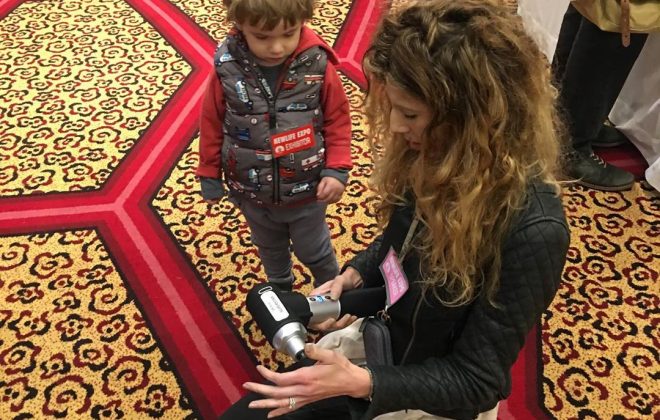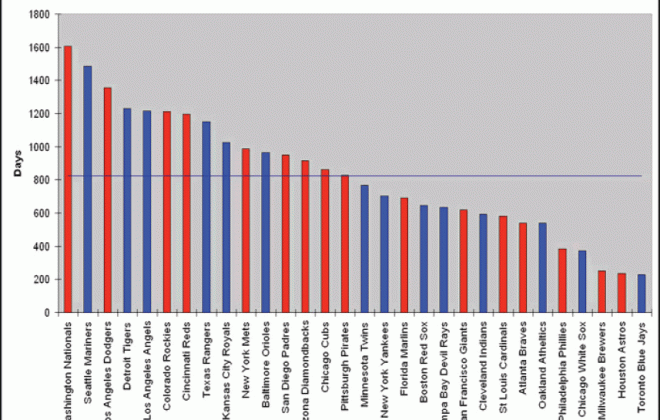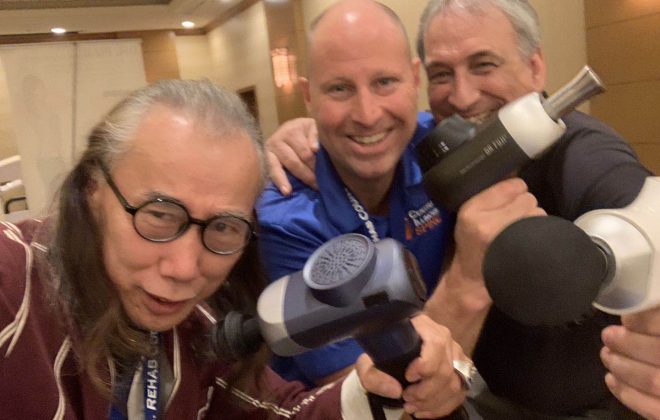Fascial Release Using the Deep Muscle Stimulator to Improve Neck-Shoulder Pain
Fascial therapy has become a very popular technique over the past several years. Fascia is the term applied to all of the connective tissues fibers and glue of the human body. Many tools to perform fascial therapy have gained popularity amongst Chiropractors, physiotherapists, personal trainers, and massage therapists. In addition to our hands (ART, myofascial release), key instruments used for fascial therapy are Sound Assisted Soft Tissue Mobilization (SASTM) tools, Graston tools and the Deep Muscle Stimulator (DMS).
This essay aims to present the results of 30 patients performing the overhead deep squat assessment and discuss how the Deep Muscle Stimulator can be applied as the therapy to fascial dysfunction to improve the quality of the overhead deep squat assessment. The average numerical pain score (0-10, 10 being the worst pain) improved by 2-3 points with one 15 minute DMS treatment
Tom Myers, Luigi Stecco, Mike Clark, and many others have made significant contributions to our understanding of fascia, fascial connections, and fascial therapy. Though the diagnosis and treatment of fascial syndromes is varied and unfolding, one of the main focuses of treatment is on the concept that the endofascial fibers and interfascial planes need to glide along each other, stay hydrated, and not get stretched faster than they can allow. Myer’s work has been identifying the fascial interconnections that he calls anatomy trains. Recently there has been a wealth of research demonstrating evidence for fascial injury, remodeling, and evidence for effects of intervention. Poor fascial gliding could cause adverse tension, and given that many mechanoreceptors are embedded within fascia, altered proprioceptive afferents could then result in non-physiologic movements at joints.
Over the last 11 years Dr. Jake Pivaroff has developed a comprehensive assessment and treatment approach using a hand held device called the Deep Muscle Stimulator or ‘DMS’ that delivers vibration and percussion to the muscles and fascia. The DMS is made of stainless steel and titanium. The 2 inch round vibrating head moves at 2200 RPMs. Application of the DMS provides a vibratory sensation of 2-4 inches from the point of contact on the body. Hyperemia caused by the vibration could modify the extracellular matrix and restore gliding of mechanically stuck fascia. Dr. Pivaroff based the design and treatment of the DMS on original ideas, clinical experience and expertise.
I have used the overhead squat assessment and analysis on hundreds of individuals and provided fascial therapy using the DMS to improve movement and stability dysfunction. The overhead squat assessment as described by Clark & Lucett in their book NASM Essentials of Corrective Exercise Training assesses dynamic flexibility, core strength, balance, and overall neuromuscular control. The overhead squat test is performed with the individual standing with the feet shoulder-width apart and pointed straight ahead. The foot and ankle complex should be in a neutral position with shoes off. The client raises the arms overhead, with the elbows fully extended. The upper arm should bisect the torso. The client is instructed to “Sit back as if you are sitting in a chair” and return to the starting position. This is repeated 5 times. The assessment is similar to the overhead deep squat based on the Functional Movement Screen by Cook and Burton.
The key features of my client evaluation and treatment includes a static posture analysis, functional movement screen using the overhead deep squat assessment, and palpation of soft tissues and joints. Treatment includes inhibitory techniques (myofascial release using the DMS), then teaching clients stretching or lengthening techniques of overactive muscles, teaching clients how to perform activation techniques (isolated local and global muscle control stability retraining), and teaching clients whole body integrated dynamic movements. This is the corrective exercise continuum as taught by the National Academy of Sports Medicine (NASM).
One of the key principles in the DMS vibration is that it improves blood flow which can speed up recovery by increasing the availability of important nutrients as well as removing damaged tissue. Two practitioners each observed 15 different patients with neck-shoulder pain using the overhead squat assessment to identify overactive muscles and fascial structures. The overhead squat assessment reveals common patterns of overactive myofascial structures. The most common compensation patterns observed are: one or both feet turn out, one or both knees move inward, the torso leans forward, the arms fall forward, and the head forward – chin poke posture occurs. In the literature these muscles have been shown to be dominant and overactive: gastrocnemius, soleus, adductors, hamstrings complex, psoas, TFL, rectus femoris, piriformis, quadratus lumborum, erector spinae, pectoralis major/ minor, latissimus dorsi, teres major, upper trapezius, levator scapulae, SCM, scalenes.
For the purposes of this study the DMS was used over the gastrocsoleus, biceps femoris, TFL/ ITB, latissimus dorsi, and levator scapulae. By treating these muscles with the DMS, changes in posture and alignment during movement were improved, as well as pain scores.
The DMS can help identify the most likely site of the source of pathology and symptoms which is often at a distance from the actual site of pain. The DMS technique involves vibration over the overactive muscles (to the deep muscular fascia) and is always applied at a distance from the actual site of pain. In this way, the method can be applied safely even during the acute phase of a cervical dysfunction. For example it is well known that excess lumbo-pelvic extension is associated with back pain and this can be caused by overactive hamstrings. Uncontrolled scapula forward tilt caused by overactive pectoralis and levator scapulae and underactive mid/ lower trapzius muscles is associated with shoulder ‘impingement’ type symptoms; Yarwood et al did a study in 2011 that showed DMS exposure shows increases in ROM in those participants who have low and decreased flexibility for shoulder flexion and shoulder external rotation.
Within the myofascial and joint system uncontrolled movement needs to be controlled eg uncontrolled scapula forward tilt, uncontrolled lumbar flexion, uncontrolled lumbo-pelvic rotation. This is usually treated with stabilization exercises. However it’s important for treatment and rehab to identify the lack of give within the myofascial and joint systems. I find using the DMS reveals the taut and tender sites within the myofascial system. By moving the DMS device in multi-directional movements (side to side, up and down, criss-cross) I can differentiate muscle fibers and lack of fascia glide. Locating tissues that do not glide or are overactive will guide the treatment process.
Merging DMS into my practice has provided a useful tool for skin and surface tissue stimulation to enhance fascial proprioception. Kinser et al report positive results of flexibility following a stretching with vibration protocol. Tom Hydes has been doing a combination of motion with the Graston tools for many years. Direction of movement using the DMS is important in clinical terms.
Because each participant improved their neck-shoulder pain score, I think this shows the possible relationship between lower extremity involvement, possible previous injury (muscle, bone, etc) and residual and/or distant fascial adhesions. Fascial adherences and muscle overactivity may limit the patient’s ability to adapt to new strains and or posture patterns (that is, sitting at a computer for prolonged periods). I find that treatment of these distance sites of myofascial tightness can relieve pain, and produce an immediate change in neck-shoulder symptoms. There may be a release of tension along an entire myofascial connection from the feet, knees, hips, or lumbopelvic region that helps the neck.
Effective myofascial release may improve the release of tension, decrease activity of overactive neuromyofascial tissues, improve local stability muscle (to control translation) recruitment, and improve functional movements such as the squat. There is general agreement that lack of stability in the myofascial system will result in uncontrolled translation at a motion segment. If muscle length is altered resulting in ineffective active stability mechanisms, then tension development will be reduced and the muscle system (to control through range movements) will be unable to generate proper force for efficient movement. There is an optimum length tension relationship that the DMS can help restore. Any dysfunction in this system will result in faulty range at one or more motion segments.
In the clinical environment the overhead squat assessment can be used to assess for dynamic flexibility, core strength, and overall neuromuscular control. Any movement pattern dysfunction should be matched with symptoms and disabilities.
Using the DMS as an assessment tool to provide local therapy to a suspected overactive muscle and then repeating the overhead squat assessment and noting improvement or lack of change, can help the practitioner make prioritizing decisions about the choice of location and which myofascial structures to target therapy. In other words, if a change was made that improved the squat, then the specific muscle treated would also need to be stretched at home on there own. Teaching patients which muscles need strengthening is also an important component to treatment.
I use DMS treatments to focus on fascial release.
Using the DMS principles is a huge advantage to therapists retraining movement faults in patients with mobility disorders. A specific assessment is needed to identify the individual’s dysfunction and once established DMS therapy can be used to retrain the movement faults.
Dr. Jeffrey Tucker is a certified instructor for the Functional Movement Screen (FMS) workshops, the National Academy of Sports Medicine (NASM) workshops, and is a post-graduate instructor for the entire Diplomate program offered by the American Chiropractic Rehabilitation Board.





